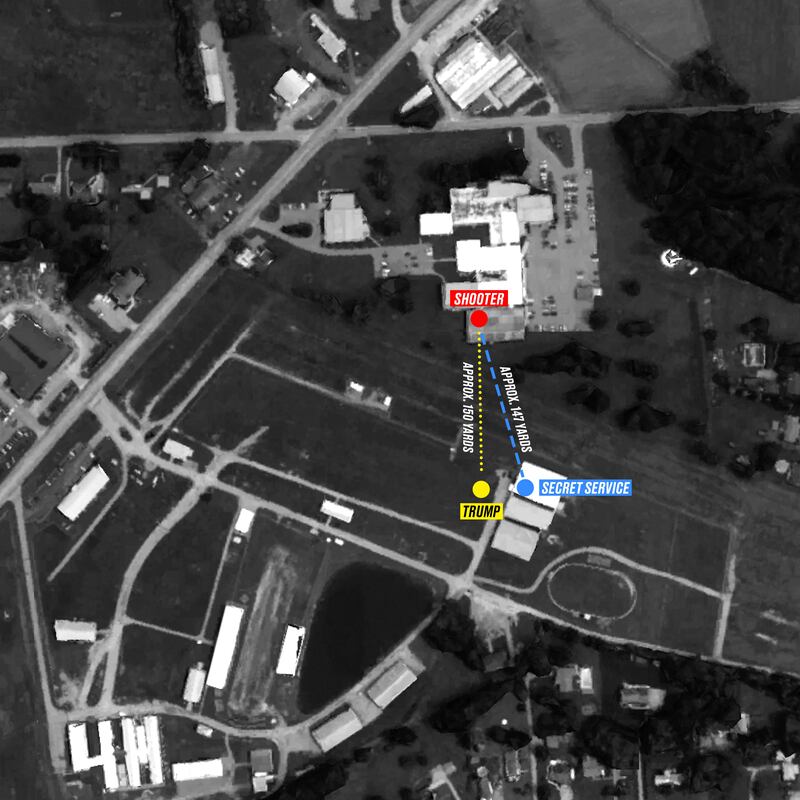The two greatest intelligence and security failures in U.S. history were the totemic sneak attacks on Pearl Harbor and 9/11.
Separated by 60 years, both failures shared striking similarities. Clues to both were available in the raw intelligence gathered by the U.S. but they slipped through the gaps of multi-agency cooperation, poorly focused resources and a failure of imagination. The failings were profound but at least they were understandable—the security failure on Saturday that allowed a sniper to fire shots at President Donald Trump was just plain dumb.
How on earth could you not secure the single most obvious elevated sniper position directly overlooking the site of a presidential candidate’s speech?
Under standard procedure for these events, the advance team, Secret Service and local law enforcement would identify potential sniper platforms for a perimeter shooter. Security would then usually be placed on the roofs or at the very least law enforcement would block access to the potentially risky sites. In this instance, the roof used by the attacker was by far the most obvious elevated location and it was well within range for a gunman with an AR-style rifle like the one used this weekend.
Studying satellite images of the rural site, it is immediately clear that there are only a handful of high-risk sniper platforms within range of Trump’s stage. This should have been a relatively simple location to secure.

Images from Google Earth show that there are only a small number of buildings within the range of a sniper rifle.
Illustration by Elizabeth Brockway / Google EarthA former Department of Homeland Security senior official said he was concerned about “how and why someone could have gotten that close with a long range weapon. It was outside the perimeter.”
“If it’s true that the structure was only 150 yards away, that’s what we call danger close, too close, you have to push your perimeter out. At 200 yards you don’t have to be a very good shot to hit someone if you have rifle.
“My concern is that the bad actor was only 150 yards away, and he was in maximum effective range of the weapon.”
The source, who asked to remain anonymous, said the director of the Secret Service Kim Cheadle was the best boss he had ever had: “The knock on her is that fiscally she’s outstanding, fiscally she’s dynamite, but operationally the knock on her is that she’s under exposed operationally. She ran the VPs, Gore and Cheney, and then Biden as Veep, but operationally it’s not the same as running the presidents.”
He added that he understood Cheadle would now be put under pressure, but the Secret Service were not partisan. “Once one of the presidents asked me which side I was actually on and I said Sir, we don’t think that way. I am on the side of the Constitution.”
The Secret Service has already launched an investigation into how this blunder was allowed to happen. It shouldn’t last as long as the multitude of probes into 9/11 and Pearl Harbor.
The 9/11 Commission reported back almost three years after the Twin Towers were brought down. It found that “The overriding conclusion was that the government’s principal failure in 9/11 was a failure to ‘connect the dots.’”
The report said Presidents Bill Clinton and George W. Bush had not been “well-served” by the CIA and FBI. A separate special report by the Office of the Inspector General also dated 2004 found that the FBI was failing to properly analyze and share the intelligence it was gathering with the rest of the intel community. For example, the pursuit of information relating to two of the 9/11 terrorists, Nawaf al Hazmi and Khalid al Mihdhar, was compromised by systemic failings. The CIA had been tracking them overseas, but they didn’t have jurisdiction on American soil and they never handed over responsibility to the FBI to keep watching the men once they were inside the United States. Flags had also been raised about flight school students and the potential use of kamikaze-style attacks but they were not properly shared.
The U.S. was hoovering up huge amounts of intelligence via 18 intelligence agencies including Naval, Army and Air Force Intelligence and the National Security Agency (NSA) but failing to put it to good use. Millions of intercepted messages and satellite images were stuck in a years-long wait to be analysed.
The problem was relatively simple but hugely difficult to resolve.
The response after 9/11 was the establishment of new umbrella organizations: the Office of the Director of National Intelligence to “coordinate” other intelligence agencies; the Department of Homeland Security; and the TSA to belatedly federalize border control.
According to multiple inquiries held in the years after, many of the same problems had hampered U.S. intel agencies ahead of Pearl Harbor. The U.S. Army, for example, was responsible for monitoring the Japanese Army, while the U.S. Navy watched their navy. Communication between the two was so weak that patterns showing Japan preparing for the attack were missed. Not only that, the Navy and Army didn’t even communicate well enough to know when one of their planes was appearing on the other’s radar, thus radically reducing the utility of the early warning system.
The day before the attack, the Army’s Signal Intelligence Service (SIS) intercepted a message from Japan to its diplomats inside the U.S. saying that they had decided months of negotiations were now over and there would be no peace with the United States. It wasn’t until the attack was underway less than 24 hours later that intel analysts realized how important that message had been.
Other messages which could have offered vital clues before the Dec. 7, 1941 attack were not decrypted and translated until years later.
Like any other event even close to the scale of Pearl Harbor, there are dozens of conspiracy theories that try to ascribe sinister motives to the intel failings, but the truth is: Intel collection was too casual, poorly shared and not disseminated to the key decision makers. Just like 9/11.
What did the U.S. do after investigating Pearl Harbor? It set up new intelligence agencies in 1947 that were supposed to share their intel better. That included a Central Intelligence Agency (CIA) and the National Security Council which coordinated between intelligence agencies and government departments.
Yes, the U.S. was breached again on Sept. 11, 2001, but huge strides forward had been taken. The sophistication of the U.S. intelligence operation had come on leaps and bounds.
Sixty-one years after JFK was shot dead by a sniper in an elevated position, why hasn’t the Secret Service made similar progress?
The lessons have not been learned—despite the near miss with President Ronald Reagan.
President Franklin D. Roosevelt described the assault on Pearl Harbor as “a date which will live in infamy.” For the Secret Service, Saturday’s assassination attempt on Trump will go down as the day of their greatest ignominy.
Nico Hines covered U.S. politics in Washington, D.C. for The Times of London and was London Bureau Chief for Newsweek before becoming The Daily Beast World Editor. As a foreign correspondent he has reported from NATO’s front line with Russia in the Arctic Circle, camped out with the families of trapped Chilean miners in the Atacama desert, and chased down terror suspects in Sydney.







